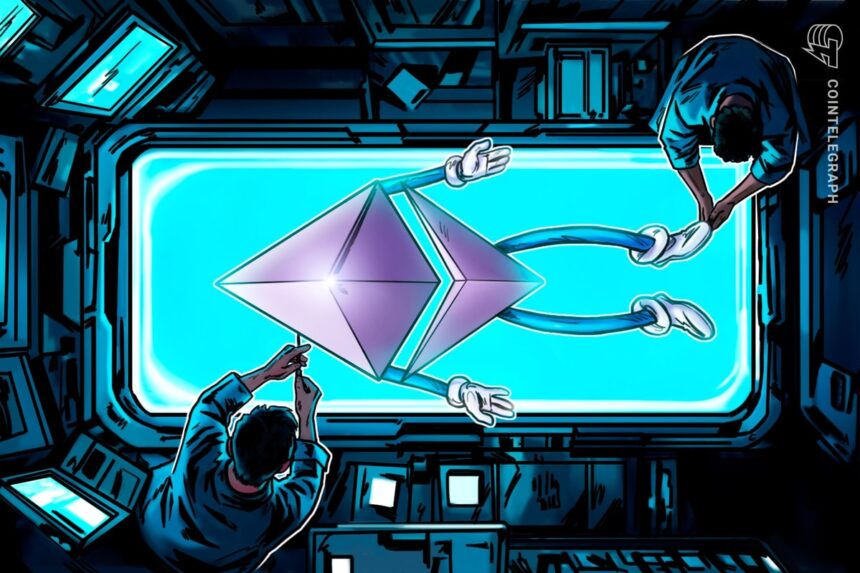Ethereum’s subsequent improve, Fusaka, goes dwell in November forward of Devconnect
Ethereum’s upcoming Fusaka exhausting fork is slated for early November 2025, setting the stage for probably the most consequential Ethereum community upgrades in years.
Unlike Pectra, the May 2025 fork that delivered seen modifications like account abstraction and better staking limits, Fusaka operates behind the scenes. It bundles 11 Ethereum Improvement Proposals centered on scalability, node resilience and effectivity, leaving sensible contracts untouched.
A devnet launched in July 2025 and a spherical of Ethereum testnets in September and October will stress‑check the modifications earlier than mainnet activation.
Developers intention to ship forward of the Devconnect convention in Buenos Aires, aligning with Ethereum’s accelerated six‑month improve cadence and rising give attention to core efficiency.

Did you already know? Fusaka joins a lineage of a few dozen execution‑layer exhausting forks (from Frontier in 2015 by Pectra in 2025).
Ethereum’s Fusaka exhausting fork defined
So, what’s the Fusaka exhausting fork? It’s the subsequent Ethereum improvement milestone, touchdown solely six months after Pectra.
As a part of the chain’s 2025 roadmap, Fusaka emphasizes Ethereum scalability updates and node well being somewhat than user-facing options.
The timeline is tight: Devnet‑3 went dwell in July 2025, public Ethereum testnets observe in September and the mainnet fork is ready for Nov. 5, 2025, coordinated to hit a predefined block peak.
The alternative of date is strategic, aligning with Ethereum neighborhood updates round Devconnect. By specializing in protocol refinement, this crypto exhausting fork lays the groundwork for future proposals like block‑time discount whereas sustaining Ethereum’s popularity for regular, iterative progress.
Upcoming Ethereum community upgrades
The Ethereum Fusaka improve is about tuning Ethereum’s core engine. The November 2025 Ethereum exhausting fork bundles 11 infrastructure-level EIPs that refine scalability, enhance effectivity and harden the community with out breaking current contracts.
Here’s a breakdown of what’s delivery:
- EIP‑7594 – PeerDAS: A significant step in Ethereum scalability updates, this introduces peer knowledge availability sampling so nodes don’t must obtain full knowledge blobs, lightening the load and boosting rollup efficiency.
- EIP‑7825 – Spam Resistance Checks: Often cited in Ethereum information because the headline merchandise, this EIP prevents malicious transaction spam, serving to nodes keep secure below excessive demand.
- EIP‑7823 – MODEXP Parameter Limit: Caps modular exponentiation enter sizes, strengthening Ethereum’s resilience to denial‑of‑service assaults.
- EIP‑7883 – MODEXP Gas Cost Adjustment: Adjusts gasoline pricing for heavy cryptographic operations, an essential Ethereum effectivity enchancment.
- EIP‑7892 – Blob Parameter‑Only Forks: Creates a framework for light-weight blob‑associated tweaks in future forks, aligning with the Ethereum 2025 roadmap.
- EIP‑7917 – Deterministic Proposer Lookahead: Precomputes block proposers to streamline validation, helpful for rollups and staking operations, and famous in lots of ETH staking updates.
- EIP‑7918 – Blob Base Fee Bound: Links blob charges to execution prices for fairer, extra predictable pricing.
- EIP‑7934 – RLP Execution Block Size Limit: Puts an higher cap on encoded block sizes, limiting bloat and supporting Ethereum scalability with out breaking compatibility.
- EIP‑7935 – Default Block Gas Limit: Lays out the Ethereum gasoline restrict enhance 2025, beginning round 45 million and scaling towards 150 million models, enabling extra transactions per block.
- EIP‑7939 – CLZ Opcode: Adds a “depend main zeros” instruction, helpful for cryptography, compression and bit‑stage optimizations.
- EIP‑7951 – secp256r1 Precompile: Brings native assist for the P‑256 elliptic curve, bridging Ethereum nearer to Web2 safety requirements and wallets.
By pulling heavier proposals like EIP‑7907 and the EVM Object Format from this fork, builders saved Fusaka centered and testable.
The result’s set to be a secure crypto exhausting fork that delivers vital back-end upgrades with out disrupting DApps, precisely the sort of incremental refinement Vitalik Buterin Ethereum is understood for.
Ethereum 2025 roadmap
The path to Fusaka’s activation is aggressive however deliberate, reflecting Ethereum’s new semiannual rhythm of upcoming Ethereum community upgrades.
Devnet‑3 spun up on July 23, 2025, giving builders a contained house to hammer on EIPs and stress‑check scalability tweaks. After that, consideration shifted to September’s two public Ethereum testnets, brief, intense cycles the place shopper groups, node operators and DApp builders can uncover bugs earlier than they hit mainnet.
A agency EIP freeze on Aug. 1 locked the scope, permitting roughly six weeks for interoperability checks, bug bounties and launch sprucing. Mainnet activation is slated for Nov. 5-12, pinned to a block peak that lands simply earlier than Devconnect.
Here, it may be famous how the Ethereum 2025 roadmap blends self-discipline with ambition (every blockchain improve will get examined, fastened and launched on schedule, whereas builders quietly put together the subsequent wave).
Did you already know? Ethereum’s theoretical TPS ceiling remains to be modest. Based on present settings (≈ 36 M gasoline restrict, 12s block time), the utmost throughput tops out at round 142 transactions per second, effectively under fee networks like Visa. Fusaka’s tweaks to gasoline limits and block-time proposals might assist push that greater.
Ethereum block time discount proposal and gasoline restrict will increase in 2025
Fusaka is partly a response to Ethereum neighborhood updates and convention deadlines.
With Devconnect Buenos Aires on the horizon (Nov. 17-22, 2025), core contributors have been blunt concerning the stress to ship.
As protocol‑assist member Nixo warned,
“If we need to ship by Devconnect, we’d like our timeline TIGHT.”

Even as Fusaka nears launch, consideration is shifting towards Ethereum improvement for 2026’s Glamsterdam fork. That improve might convey daring modifications like an Ethereum block time discount proposal (EIP‑7782) to 6 seconds, successfully doubling throughput and making the community really feel snappier for wallets and layer 2s.
Other conversations contain additional gasoline‑restrict changes, ETH staking updates and assist for the increasing DeFi load. Decisions will crystallize on the Aug. 1 AllCoreDevs – Execution assembly, proving that Ethereum’s tradition of steady, clear evolution could be very a lot alive.
Ethereum testnets September 2025: What customers and builders ought to know
For builders, Fusaka is a quiet powerhouse. Higher gasoline ceilings (with an preliminary transfer towards 45 million and scaling up) translate to extra transactions per block, whereas PeerDAS relieves node workloads and improves rollup efficiency.
Crucially, none of those Ethereum scalability updates break contracts or interfaces; DApps and purchasers stay absolutely suitable, an essential reassurance for builders.
For on a regular basis customers, the Ethereum effectivity enhancements received’t scream for consideration, however they’ll discover steadier gasoline charges and smoother transaction circulate throughout excessive‑visitors moments.
Yet commerce‑offs lurk; an even bigger gasoline restrict raises storage and bandwidth calls for, which might pressure smaller validators and nudge the community towards heavier reliance on industrial‑scale operators.
Still, Fusaka’s measured method (refining the plumbing with out overhauling the home) embodies the ethos of Vitalik Buterin’s Ethereum: Iterate, enhance and make house for the subsequent leap, all whereas balancing efficiency with decentralization.











